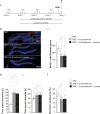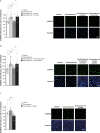Role of adult hippocampal neurogenesis in the antidepressant actions of lactate
- PMID: 33990772
- PMCID: PMC8760055
- DOI: 10.1038/s41380-021-01122-0
Role of adult hippocampal neurogenesis in the antidepressant actions of lactate
Abstract
In addition to its role as a neuronal energy substrate and signaling molecule involved in synaptic plasticity and memory consolidation, recent evidence shows that lactate produces antidepressant effects in animal models. However, the mechanisms underpinning lactate's antidepressant actions remain largely unknown. In this study, we report that lactate reverses the effects of corticosterone on depressive-like behavior, as well as on the inhibition of both the survival and proliferation of new neurons in the adult hippocampus. Furthermore, the inhibition of adult hippocampal neurogenesis prevents the antidepressant-like effects of lactate. Pyruvate, the oxidized form of lactate, did not mimic the effects of lactate on adult hippocampal neurogenesis and depression-like behavior. Finally, our data suggest that conversion of lactate to pyruvate with the concomitant production of NADH is necessary for the neurogenic and antidepressant effects of lactate.
© 2021. The Author(s).
Conflict of interest statement
The authors declare no competing interests.
Figures





Similar articles
-
Peripheral administration of lactate produces antidepressant-like effects.Mol Psychiatry. 2018 Feb;23(2):392-399. doi: 10.1038/mp.2016.179. Epub 2016 Oct 18. Mol Psychiatry. 2018. PMID: 27752076 Free PMC article.
-
Blockade of 2-arachidonoylglycerol hydrolysis produces antidepressant-like effects and enhances adult hippocampal neurogenesis and synaptic plasticity.Hippocampus. 2015 Jan;25(1):16-26. doi: 10.1002/hipo.22344. Epub 2014 Aug 27. Hippocampus. 2015. PMID: 25131612 Free PMC article.
-
Role of SIRT1-mediated synaptic plasticity and neurogenesis: Sex-differences in antidepressant-like efficacy of catalpol.Phytomedicine. 2024 Dec;135:156120. doi: 10.1016/j.phymed.2024.156120. Epub 2024 Oct 4. Phytomedicine. 2024. PMID: 39395323
-
The hippocampus, neurotrophic factors and depression: possible implications for the pharmacotherapy of depression.CNS Drugs. 2011 Nov 1;25(11):913-31. doi: 10.2165/11595900-000000000-00000. CNS Drugs. 2011. PMID: 22054117 Review.
-
Depression and adult neurogenesis: Positive effects of the antidepressant fluoxetine and of physical exercise.Brain Res Bull. 2018 Oct;143:181-193. doi: 10.1016/j.brainresbull.2018.09.002. Epub 2018 Sep 17. Brain Res Bull. 2018. PMID: 30236533 Review.
Cited by
-
Vilazodone Alleviates Neurogenesis-Induced Anxiety in the Chronic Unpredictable Mild Stress Female Rat Model: Role of Wnt/β-Catenin Signaling.Mol Neurobiol. 2024 Nov;61(11):9060-9077. doi: 10.1007/s12035-024-04142-3. Epub 2024 Apr 8. Mol Neurobiol. 2024. PMID: 38584231 Free PMC article.
-
Oligodendrocyte-derived exosomes-containing SIRT2 ameliorates depressive-like behaviors and restores hippocampal neurogenesis and synaptic plasticity via the AKT/GSK-3β pathway in depressed mice.CNS Neurosci Ther. 2024 Mar;30(3):e14661. doi: 10.1111/cns.14661. CNS Neurosci Ther. 2024. PMID: 38439616 Free PMC article.
-
Paradoxical mTORC1-Dependent microRNA-mediated Translation Repression in the Nucleus Accumbens of Male Mice Consuming Alcohol Attenuates Glycolysis.Nat Commun. 2025 Jul 14;16(1):6116. doi: 10.1038/s41467-025-60337-9. Nat Commun. 2025. PMID: 40659615 Free PMC article.
-
Lactate metabolism and histone lactylation in the central nervous system disorders: impacts and molecular mechanisms.J Neuroinflammation. 2024 Nov 28;21(1):308. doi: 10.1186/s12974-024-03303-4. J Neuroinflammation. 2024. PMID: 39609834 Free PMC article. Review.
-
Hyperactive neuronal autophagy depletes BDNF and impairs adult hippocampal neurogenesis in a corticosterone-induced mouse model of depression.Theranostics. 2023 Jan 22;13(3):1059-1075. doi: 10.7150/thno.81067. eCollection 2023. Theranostics. 2023. PMID: 36793868 Free PMC article.
References
-
- Wang Q, Jie W, Liu J-H, Yang J-M, Gao T-M. An astroglial basis of major depressive disorder? An overview. Glia. 2017;65:1227–50. - PubMed
-
- Magistretti PJ, Allaman I. Lactate in the brain: from metabolic end-product to signalling molecule. Nat Rev Neurosci. 2018;19:235–49. - PubMed
-
- Allen NJ. Astrocyte regulation of synaptic behavior. Annu Rev Cell Dev Biol. 2014;30:439–63. - PubMed
Publication types
MeSH terms
Substances
LinkOut - more resources
Full Text Sources
Other Literature Sources
Medical

